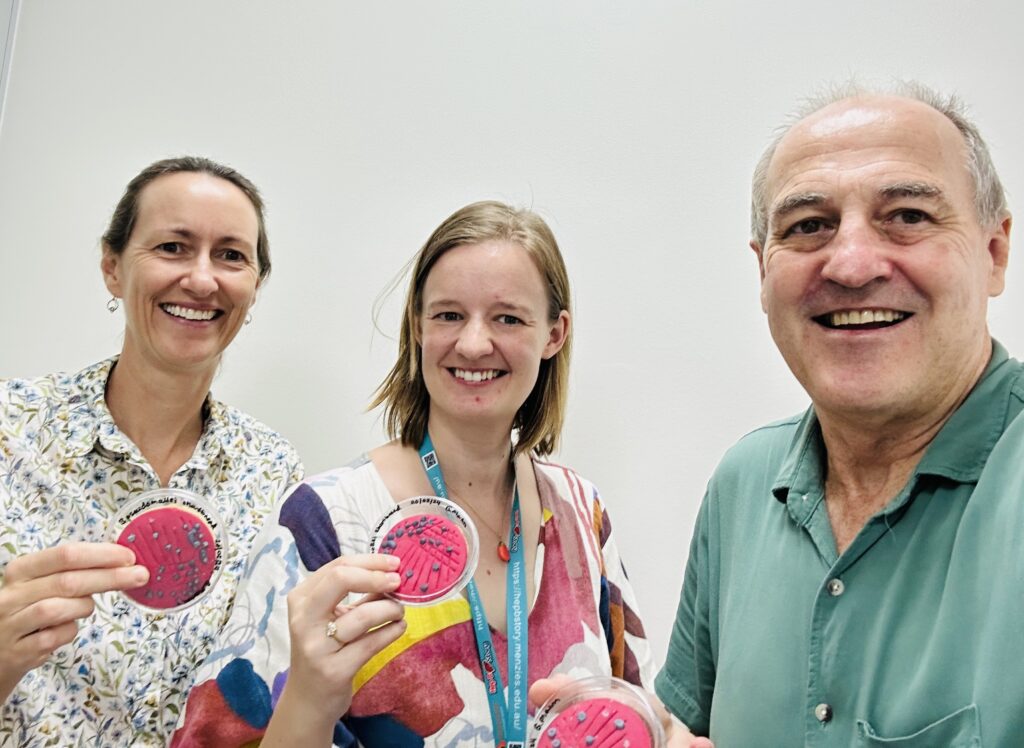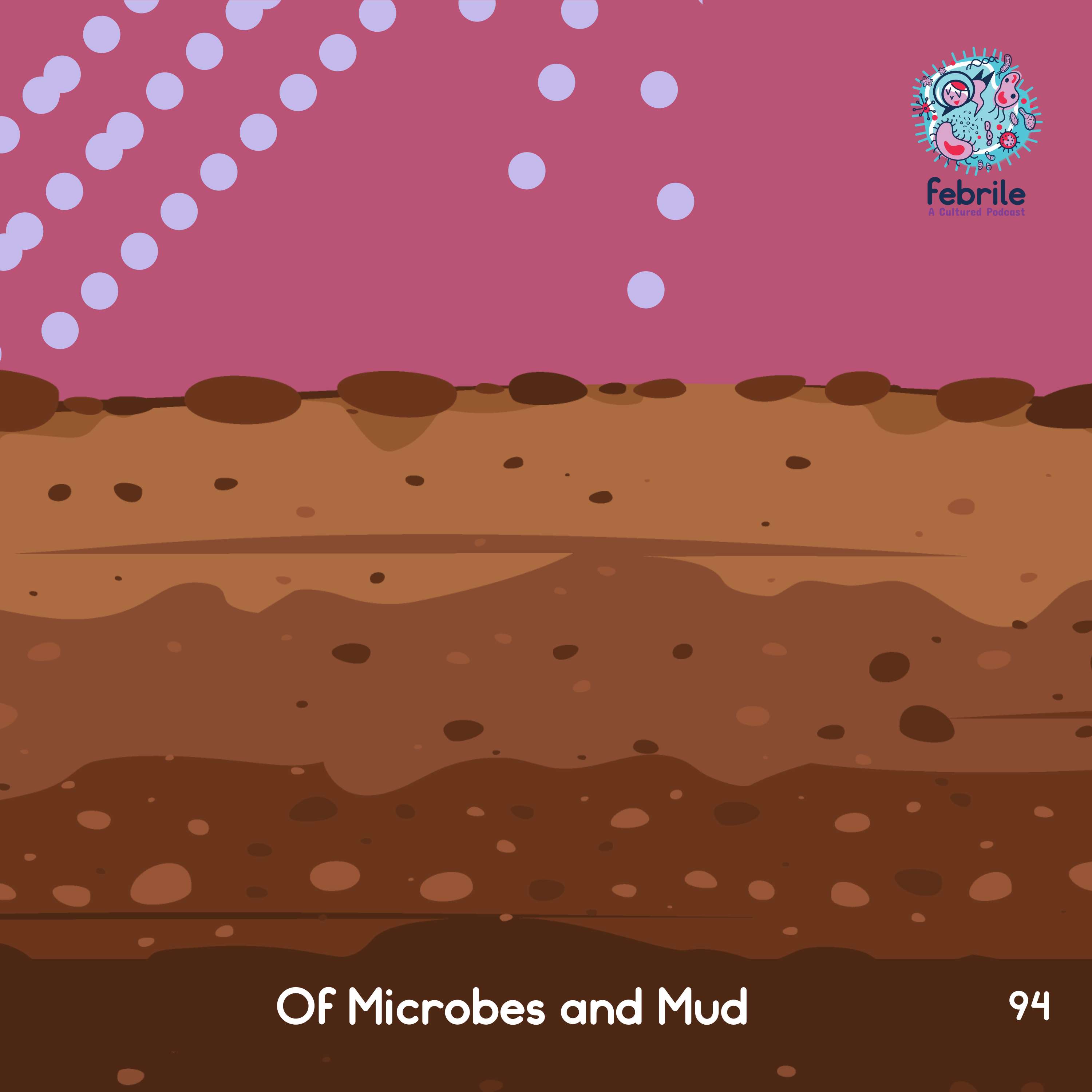Table of Contents
Credits
Hosts: Genevieve Martin, Sara Dong
Guest Discussants: Catherine Marshall, Bart Currie
Writing: Genevieve Martin
Content Editing, Infographics, Cover Art: Sara Dong
Audio Editing/Mixing: Bentley Brown
Produced by Sara Dong with support from the Infectious Diseases Society of America (IDSA)
Our Guests
Check out this wonderful team photo and Genevieve’s delightful melioidosis plate biscuits/cookies !

Dr Catherine Marshall
Dr Catherine Marshall is the Co-Director of the Department of Infectious Diseases and an ID physician at Royal Darwin Hospital. She completed her ID training at the Alfred Hospital in Melbourne, and she also completed an MPH.
Dr Genevieve Martin
Dr Genevieve Martin is an Infectious Diseases Advanced Trainee at the Royal Darwin Hospital in the Northern Territory, Australia. She completed her PhD in the immunology of early HIV infection and HIV cure approaches at the University of Oxford in 2018. She is passionate about understanding the interactions between pathogens and the immune system and aspirates to combine clinical work as an ID physician with her research
Professor Bart Currie
Professor Bart Currie is a senior staff specialist ID physician at the Royal Darwin Hospital, where he was the Director of ID until 2019. He was initially head of the Menzie Clinical Division and the Interim Director of the Menzies School of Health Research, and he now leads the Tropical and Emerging Infectious Diseases team within the Global and Tropical Health Division. His collaborations with clinical and scientific colleagues have resulted in hundreds of peer reviewed publications.
Culture
- Genevieve just started reading “The Bee Sting” by Paul Murray
- Catherine shared how she loves to visit the Darwin National Aboriginal & Torres Strait Islander Art Awards at the Museum and Art Gallery of Northern Territory. Check out some archives at this link
- Bart shared that snakes have been unusual in their behavior in last few months! More on the move and newborns have been hatching, so there have been several snakebites!
Consult Notes
Case Summary
42 yo male presents with cough and fevers from a remote community in the Northern Territory Australia during the wet season. He was found to have melioidosis
Key Points
Key References
Burkholderia pseudomallei or melioidosis epidemiology
- An infection caused by the facultative intracellular Gram negative bacteria B.pseudomallei
- Historically endemic areas include Southeast Asia, northern Australia, South Asia, and China → with the majority of cases from Thailand, Malaysia, SIngapore, and northern Australia
- Cases have been described in other regions though, and the global distribution remains unclear
- Most of these will be cases acquired by visitors to endemic areas
- Sporadic human and animal cases that are no travel related though have been reported, making the boundaries less clear
- See the section on the US later for more details…
- Transmission can occur via:
- Percutaneous inoculation → the predominant mode of transmission during exposure to wet season soils or contaminated water
- Cases of pneumonia after presumptive inoculation of skin injuries are well documented → suggesting infection reaches lungs via hematogenous route
- Inhalation
- Aspiration
- Occasional ingestion
- Percutaneous inoculation → the predominant mode of transmission during exposure to wet season soils or contaminated water
- Risk factors for melioidosis
- In endemic areas, the environmental exposure to soil and water is an important risk. Activities such as gardening or landscaping and the season are important as well. Severe weather events like monsoons can be associated with local clusters of infection as well
- Important comorbidities include: diabetes mellitus, alcohol use, chronic kidney disease, chronic lung disease
- Incubation period can range from 1-21 days but mean is about 5-9 days → this is likely influenced by inoculating dose, mode of transmission, and host risk factors
- Additional references (also see first section!):
- Currie BJ, Dance DA, Cheng AC. The global distribution of Burkholderia pseudomallei and melioidosis: an update. Trans R Soc Trop Med Hyg. 2008;102 Suppl 1:S1-S4. doi:10.1016/S0035-9203(08)70002-6
- Limmathurotsakul D, Golding N, Dance DA, et al. Predicted global distribution of Burkholderia pseudomallei and burden of melioidosis. Nat Microbiol. 2016;1:15008. Published 2016 Jan 11. doi:10.1038/nmicrobiol.2015.8
- Here is an online map at https://www.melioidosis.info/map.aspx in addition to references provided
- Currie BJ, Fisher DA, Howard DM, et al. The epidemiology of melioidosis in Australia and Papua New Guinea. Acta Trop. 2000;74(2-3):121-127. doi:10.1016/s0001-706x(99)00060-1
- Suputtamongkol Y, Chaowagul W, Chetchotisakd P, et al. Risk factors for melioidosis and bacteremic melioidosis. Clin Infect Dis. 1999;29(2):408-413. doi:10.1086/520223
Melioidosis in the USA
- As Bart discussed, cases of melioidosis in the US are rare and typically travel associated, but there have recently been several non-travel-related cases and evidence supporting that B.pseudomallei is potentially endemic in the southern US
- B.pseudomallei has been identified in environmental samples of soil and water from the Mississippi Gulf Coast region, which were genetically linked to isolates cultured from 3 unrelated patients who presented with melioidosis. Petras JK, Elrod MG, Ty MC, et al. Locally Acquired Melioidosis Linked to Environment – Mississippi, 2020-2023. N Engl J Med. 2023;389(25):2355-2362. doi:10.1056/NEJMoa2306448
- There also has been another non-travel-related case in Texas: Cossaboom CM, Marinova-Petkova A, Strysko J, et al. Melioidosis in a Resident of Texas with No Recent Travel History, United States. Emerg Infect Dis. 2020;26(6):1295-1299. doi:10.3201/eid2606.190975
- You may also remember the cases in a multistate outbreak recently identified from imported aromatherapy spray
Clinical features of melioidosis
- Infections may be asymptomatic or subclinical in most cases, and severe disease typically occurs in those with certain comorbidities
- Most cases occur in adults. When cases in children do occurs, they tend to be less severe
- Acute infection is typically pneumonia, which accounted for over half of cases in the Northern Territory of Australia
- Other sites of infection include skin and soft tissue, genitourinary tract, and visceral abscesses (often noted in spleen, kidney, prostate)
- Bacteremic spread of the organisms can result in disease at almost any body site
- Chronic infection can occur with majority of these presenting with chronic pulmonary symptoms that may mimic TB or with a non-healing skin ulcer
- Latent infection with reactivation is possible, similar to TB
Diagnosis of melioidosis
- In endemic regions, melioidosis is routinely considered part of the differential diagnosis of pneumonia, ulcerated skin lesions, undifferentiated sepsis, prostatic abscess – similar to our case episode
- Outside of endemic areas, consider if individual present with syndrome, history of travel to an endemic area, and travel or residence to areas where cases are being increasingly reported
- When melioidosis is suspected, collect specimens from appropriate sites including: blood, sputum/respiratory, urine, throat swab, rectal swab, swab from any ulcer or skin lesion, pus/fluid from drainable abscesses, CSF if individual with encephalitis or meningitis (although CSF yield is low)
- Likelihood of diagnosis is increased if multiple clinical samples are sent
- As discussed in the episode, in the Northern Territory of Australia (a hyperendemic region), all cultures from blood, sputum, urine, and drainage are collected during wet season when cases peak and are processed for B.pseudomallei detection
- B.pseudomallei grows in standard blood cultures
- In cultures from non sterile sites, it can be overgrown by normal flora, so selective media can be used → our guests discussed Ashdown agar, which contains gentamicin, or Ashdown liquid transplant broth, which contains colistin
- B.pseudomallei is oxidase-positive, non-lactose-fermenting, Gram-negative bacillus → so once the organism grows, identification can be made with screening with Gram stain, oxidase reaction, typical growth characteristics, and resistance to certain antibiotics (as Bart discussed)
- Serology is generally not useful
- Other antigen and DNA detection techniques exist but are not always commercially available
Treatment of melioidosis
- B.pseudomallei is intrinsically resistant to penicillin, ampicillin, first and second generation cephalosporins, gentamicin, tobramycin, and streptomycin
- The main antimicrobial options (depending on phase of treatment) include:
- Beta-lactams (ceftazidime, certain beta-lactam-beta-lactamase-inhibitors) and carbapenems
- TMP-SMX
- Doxycycline
- Therapy generally begins with an initial intensive therapy phase
- The goal is to prevent mortality from severe illness, and this typically includes at least 2 wks of IV antibiotic therapy (although this may be 4-8 wks in some cases)
- Generally for critically ill patients, experts would use meropenem as initial therapy. There is observational data to suggest meropenem may offer mortality benefit
- Stephens DP, Thomas JH, Ward LM, Currie BJ. Melioidosis Causing Critical Illness: A Review of 24 Years of Experience From the Royal Darwin Hospital ICU. Crit Care Med. 2016;44(8):1500-1505. doi:10.1097/CCM.0000000000001668
- Cheng AC, Fisher DA, Anstey NM, Stephens DP, Jacups SP, Currie BJ. Outcomes of patients with melioidosis treated with meropenem. Antimicrob Agents Chemother. 2004;48(5):1763-1765. doi:10.1128/AAC.48.5.1763-1765.2004
- If there is concern for CNS involvement, experts use meropenem at higher dosing (40 mg/kg up to 2g IV every 8 hrs)
- In non-critically ill patients without CNS infection, could consider use of ceftazidime for initial therapy. Could also consider transition of meropenem to ceftazidime following clinical improvement for antibiotic stewardship
- In some cases, adjunctive addition of TMP-SMX may be used as well (such as those with non-pulmonary focal infections → rationale is added tissue penetration and intracellular activity of TMP-SMX). The data though is limited on this approach
- Chierakul W, Anunnatsiri S, Short JM, et al. Two randomized controlled trials of ceftazidime alone versus ceftazidime in combination with trimethoprim-sulfamethoxazole for the treatment of severe melioidosis. Clin Infect Dis. 2005;41(8):1105-1113. doi:10.1086/444456
- Chierakul W, Anunnatsiri S, Chaowagul W, Peacock SJ, Chetchotisakd P, Day NP. Addition of trimethoprim-sulfamethoxazole to ceftazidime during parenteral treatment of melioidosis is not associated with a long-term outcome benefit. Clin Infect Dis. 2007;45(4):521-523. doi:10.1086/520010
- This intensive phase is followed by oral antibiotic eradication therapy
- Considered necessary to prevent relapse
- Chaowagul W, Suputtamongkol Y, Dance DA, Rajchanuvong A, Pattara-arechachai J, White NJ. Relapse in melioidosis: incidence and risk factors. J Infect Dis. 1993;168(5):1181-1185.
- Limmathurotsakul D, Chaowagul W, Chierakul W, et al. Risk factors for recurrent melioidosis in northeast Thailand. Clin Infect Dis. 2006;43(8):979-986. doi:10.1086/507632
- Experts typically suggest PO TMP-SMX although doxycycline is an alternative agent
- The optimal duration of this phase is unknown, although most experts suggest a minimum of 3 months
- Can be extended in 6 months in those with osteomyelitis or neurologic disease
- In those with vascular involvement / mycotic aneurysms, may consider even longer duration or lifelong therapy
- Considered necessary to prevent relapse
- Other critical parts of management include
- Abscess drainage as appropriate, especially with prostatic abscess
- Supportive care
- Consideration of recombinant G-CSF for patients with septic shock
Prevention of melioidosis
- Bart discussed counseling individuals with risk factors who live in endemic areas to avoid skin exposures to soil and surface water during the wet season, including staying inside during severe weather that may increase aerosolization of B.pseudomallei
- It is recommended that patients with cystic fibrosis should avoid travel to melioidosis endemic regions during wet season
Infographics
Goal
Listeners will be able to discuss the diagnosis and management of melioidosis
Learning Objectives
After listening to this episode, listeners will be able to:
- Identify hyperendemic areas for Burkholderia pseudomallei
- Describe the common clinical syndromes associated with melioidosis
- Discuss management of severe melioidosis
Disclosures
Our guests as well as Febrile podcast and hosts report no relevant financial disclosures
Citation
Martin, G., Marshall, C., Currie, B., Dong, S. “#94: Of Microbes and Mud”. Febrile: A Cultured Podcast. https://player.captivate.fm/episode/4cf87987-c1ca-421d-a6f3-c8b974d26759


